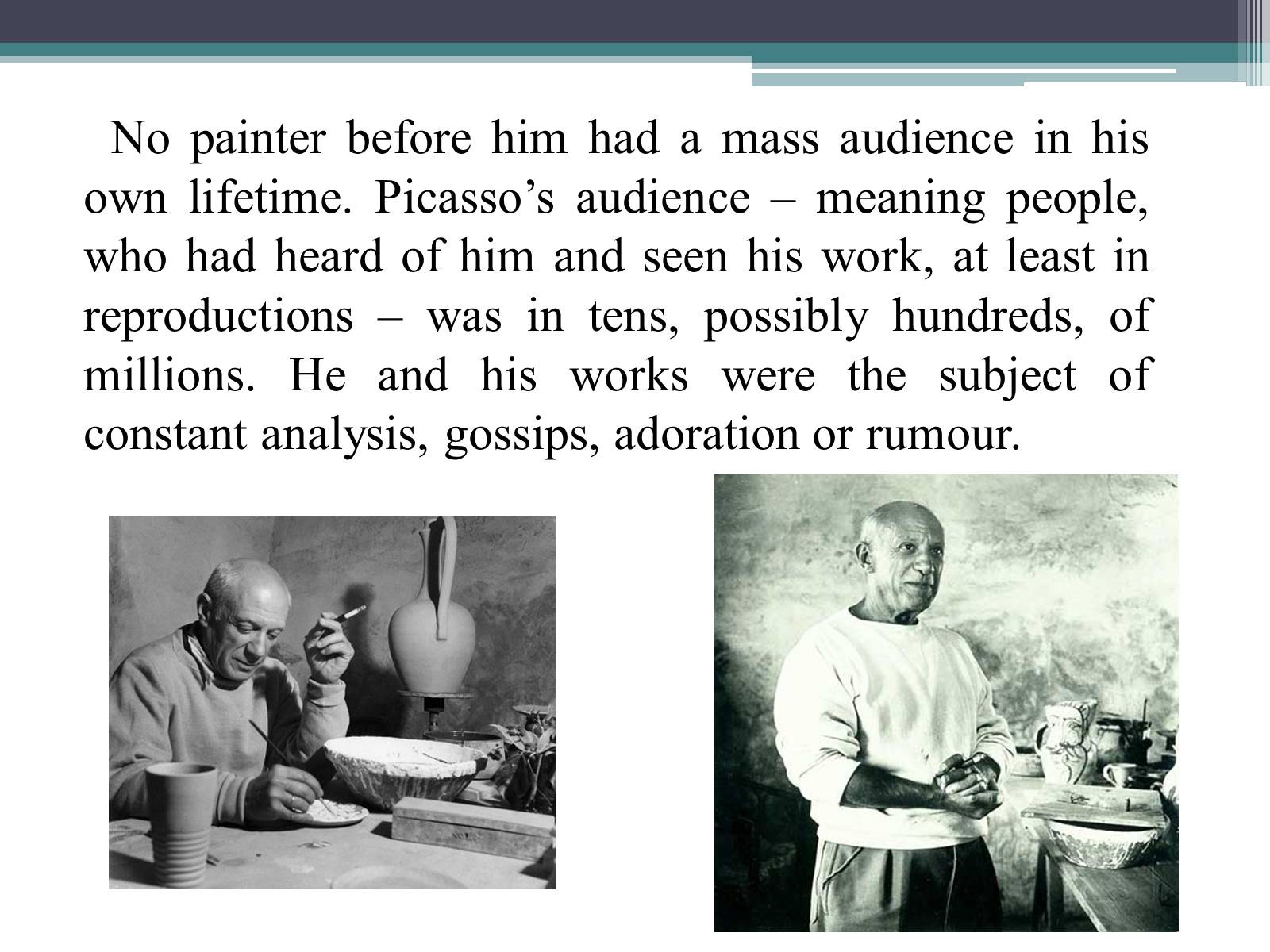Презентація на тему «Pablo Picasso» (варіант 7)

Pablo Picasso
(1881-1973)

No painter before him had a mass audience in his own lifetime. Picasso's audience – meaning people, who had heard of him and seen his work, at least in reproductions – was in tens, possibly hundreds, of millions. He and his works were the subject of constant analysis, gossips, adoration or rumour.

Pablo Picasso was born in Spain in 1881 and lived for 91 years. For most of his life he lived in Paris, France.
Full name Pablo Diego José Francisco de Paula Juan Nepomuceno María de los Remedios Cipriano de la Santísima Trinidad Clito Ruiz y Picasso.
Building on the Merced area in the Spanish city of Malaga, the birthplace of Pablo Picasso
Pablo Picasso aged 4 in 1885

When Picasso was a child, pictures by Vincent Van Gogh and Paul Cezanne were the modern masterpieces. With Picasso's fantastic imagination he took those ideas even further. He started to paint what he knew about object or person. Anything solid was broken down into flattened, cut out “pieces”. The pieces were shaped like patterns, or cubes, so the new style was called “Cubism”. When cubism first appeared some critics said it was a complete disaster. So, this style was Picasso's first gift to the art world. Picasso kept developing new styles, constantly switching between them. He painted and sculptured in any way he wanted.

When Picasso was a child, pictures by Vincent Van Gogh and Paul Cezanne were the modern masterpieces. With Picasso's fantastic imagination he took those ideas even further. He started to paint what he knew about object or person. Anything solid was broken down into flattened, cut out “pieces”. The pieces were shaped like patterns, or cubes, so the new style was called “Cubism”. When cubism first appeared some critics said it was a complete disaster. So, this style was Picasso's first gift to the art world. Picasso kept developing new styles, constantly switching between them. He painted and sculptured in any way he wanted.

Some of the greatest modern painters – Kandinsky, for instance, or Mondrian – saw his work as an instrument of evolution and human development. The idea that he had any kind of historical mission struck Picasso, and he always said that all he had ever made was made for the present and in the hope that it would remain in the present. It is interesting, that he also stood against the Expressionist belief that the work of art must disclose the truth and the inner being of its author.

Unlike many other artists Picasso wasn't poor. He had been successful nearly all his life and had plenty of money. He lived in elegant flat in a fashionable Paris street.
Self-portrait

In this work everything is based on sensation and desire. He could make people feel the weight of forms and the tension of their relationships mainly by drawing the total structure.
Picasso constantly tried out new forms of art and invented a new style, which, strangely, remained a secret for most of his life – his sculptures. He loved animals and built sculptures of them from materials he found just lying around.

In this work everything is based on sensation and desire. He could make people feel the weight of forms and the tension of their relationships mainly by drawing the total structure.
Picasso constantly tried out new forms of art and invented a new style, which, strangely, remained a secret for most of his life – his sculptures. He loved animals and built sculptures of them from materials he found just lying around.

There are painters who transform the sun to a yellow spot, but there are others who with the help of their art and their intelligence, transform a yellow spot into the sun.
~Pablo Picasso
Famous French doctor once said Pablo Picasso: "As an expert on human anatomy, I would argue that people in your pictures from a pharmaceutical point of view of great doubt." "Maybe - replied Picasso. - But I can assure you that they will live longer than your patients."